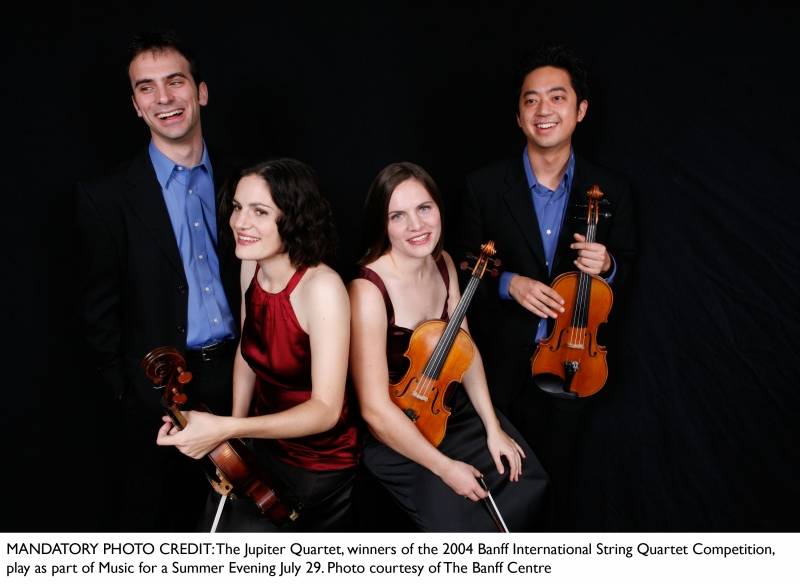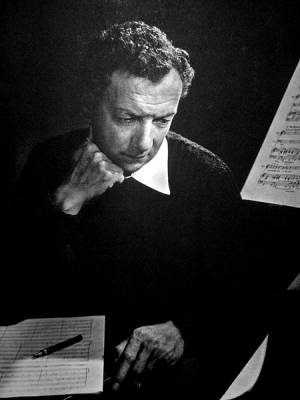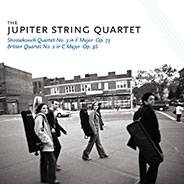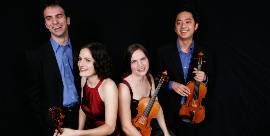The Jupiter String Quartet is a close group to say the least. They are two sisters, Meg and Liz Freivogel, a husband (and brother-in-law), Daniel McDonough, and one non-family member, Nelson Lee. This foursome has been playing together for eleven years. They know their instruments well, but not, I suspect, as well as they know each other. The Jupiters have seen Asia, Europe, and the Americas together, played in such places as Carnegie Hall and the Library of Congress, and have probably been to a lot of the same weddings.

Quartets are intimate. The members grow both emotional and musical connections while enjoying physical freedom from one another. Their movements tend to be more fluid than an orchestra’s; they explore the space because they can. The musicians in a quartet take their cues from each other, not from a conductor, and the dynamics of the group are shaped by the arch of a brow, a subtle smirk. A collective breath is the baton. Four strings provide the base for twelve, eight harmonize with eight, sixteen melt into one. I like quartets.
 Concerning the Jupiter performance on February 17 at Krannert Center for the Performing Arts, I’m not going to lie: I didn’t like the first piece. Franz Schubert’s String Quartet No. 10 was not, and is not, my cup of tea. The first movement didn’t know when to stop, and the second movement was too brief. It ended, in fact, just as I was deciding to enjoy it. I don’t blame the musicians; I don’t blame the composer. Sometimes I just don’t like things.
Concerning the Jupiter performance on February 17 at Krannert Center for the Performing Arts, I’m not going to lie: I didn’t like the first piece. Franz Schubert’s String Quartet No. 10 was not, and is not, my cup of tea. The first movement didn’t know when to stop, and the second movement was too brief. It ended, in fact, just as I was deciding to enjoy it. I don’t blame the musicians; I don’t blame the composer. Sometimes I just don’t like things.
The Jupiters’ musicianship is splendid, and I love to see artistic collaboration at this level of skill. Each movement was handled appropriately. The intense forte conclusions get a grandiose flourish from all four bows. The pianissimos are ended with a careful … backing … away.
Second on the setlist, Benjamin Britten did not make a good first impression with his String Quartet No. 1. Nelson Lee, try as he might, fell ever-so-slightly-flat as he grappled with an unnecessary succession of impossible high notes. I watched a  good violinist succumb to the trap of a gimmick. I imagined a stage direction: [He cries a single tear.] It can’t possibly convey what it’s supposed to the way an organic process would, and failing to accomplish it does not say a thing about the artist’s skill. I felt for Lee, and I was annoyed with the composer.
good violinist succumb to the trap of a gimmick. I imagined a stage direction: [He cries a single tear.] It can’t possibly convey what it’s supposed to the way an organic process would, and failing to accomplish it does not say a thing about the artist’s skill. I felt for Lee, and I was annoyed with the composer.
The second movement got Britten back on my good side. He seduced me with staccato bowing (My favorite! How did you know?) and great bursts of vibrant sound. (What a Casanova.) It was more clear than ever that Meg, Liz, Daniel, and Nelson were having a tremendous time up there. They carried that player’s high with them into the third movement, where cascades of notes fell over warm harmonies. I was in a great mood by the fourth movement, which prompted me to write “FUN” in my program.
The Jupiter String Quartet was my fourth string ensemble in eleven days and my third music review in as much time. I might have been bored by anyone at this point and, I have to admit, I was ready to be done with classical music for a while. I want more of a separation between experiences. I want to appreciate them more, in volume and frequency. It’s unfair to give a group like this 80% of my focus because I’ve read the words “allegro” and “vivace” too many times to count.
The Jupiter Quartet’s final piece, String Quartet No. 14 by Antonin Dvorak, was exactly what I was craving: a solid piece with a classic ending. I wanted my send-off (into a short hiatus) to be something vaguely familiar, but intriguing. The second  violin, Meg Freivogel, was a treat. She uses every bit of her bow, producing strong, confident tones. Her work with Lee made them both shine; it was lovely. The bouncy cello and sonorous viola rounded out the final movement, and I knew that my break from strings would be a reluctant one.
violin, Meg Freivogel, was a treat. She uses every bit of her bow, producing strong, confident tones. Her work with Lee made them both shine; it was lovely. The bouncy cello and sonorous viola rounded out the final movement, and I knew that my break from strings would be a reluctant one.
As has been the case with some other reviews, I am telling my side of this story after the characters have left the building. But do keep in mind that, although this particular fantastic quartet is now out of the confines of Krannert Center, there are more amazing groups and sounds arriving all the time. A quick glance at the online calendar for KCPA will reveal many more opportunities in our little city to enjoy wonderful art. Take a chance on one of these groups; discover something “FUN.”








